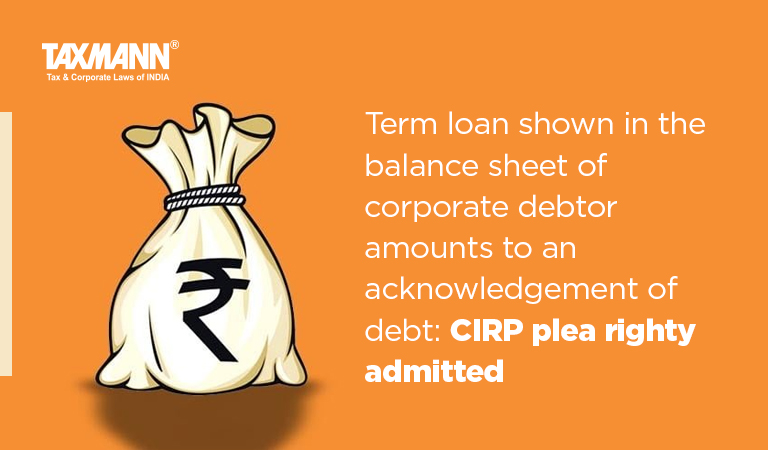Term loan shown in the balance sheet of corporate debtor amounts to an acknowledgement of debt: CIRP plea righty admitted
- Blog|News|Insolvency and Bankruptcy Code|
- 3 Min Read
- By Taxmann
- |
- Last Updated on 7 January, 2022
Case details: Hemanshu Jamnadas Domadia Shareholder & Director of Silver Proteins (P.) Ltd. v. Central Bank of India - [2021] 133 taxmann.com 351 (NCLAT- New Delhi)
Judiciary and Counsel Details
-
- Jarat Kumar Jain, Judicial Member and V.P. Singh, Technical Member
- Keith Varghese and Mohit Gupta, Advs. for the Appellant.
- Kunal Tandon and Ms. Richa Sandilya, Advs, for the Respondent.
Facts of the Case
In the Instant case, the appellant-corporate debtor had availed credit facilities from the respondent-financial creditor. The corporate debtor had defaulted to repay the loan amount. Consequently, the financial creditor classified the account of the corporate debtor as Non-Performing Asset (NPA) on 1-7-2015 and applied section 7 on 22-10-2018. Adjudicating Authority by impugned order admitted application filed under section 7.
The corporate debtor filed the appeal contending that the application filed by the financial creditor was time-barred as the date of default was 1-7-2015 but the application for initiating CIRP against the corporate debtor was filed on 22-7-2018 and, thus, the application was filed after the prescribed limitation period of three years was barred by limitation. He had also opposed that the application filed by financial creditor under section 7 was not maintainable as same was not filed by a duly authorized person of the financial creditor.
Appellant contended that the Adjudicating Authority had wrongly considered the credit entry of 30-12-2015 from the corporate debtor. The appellant submitted that the said payment was made by a completely unrelated party. The said payment is neither made by the appellant nor its agent. Therefore, based on the credit entry dated 30-12-2015 limitation period cannot be extended under section 19 of the Limitation Act, 1963.
Appellant submitted that to get the benefit of section 19 of the Limitation Act, two conditions were essential; first, payment must be made within the prescribed period of limitation, and secondly, it must be acknowledged by some form of writing either in the handwriting of payer himself or signed by him. It is the payment that extends the period of limitation. Still, payment has to be proved in a particular way, and a written or signed acknowledgement is the only proof of payment.
NCLAT Held
NCLAT observed that, since an amount was credited to corporate debtor’s account on 31-12-2015 and balance sheet proved that on 31-3-2016 there was a term loan of financial creditor, there was a clear acknowledgement that an amount was due and payable to financial creditor and, therefore, Adjudicating Authority rightly admitted application filed under section 7.
Case Review
-
- Central Bank of India v. Silver Proteins (P.) Ltd. [2021] 133 taxmann.com 350 (NCLT – Ahd.) (para 5.12) affirmed.
- Rajendra Narottamdas Sheth v. Chandra Prakash Jain [2021] 131 taxmann.com 2/168 SCL 466 (SC) (para 4.3)
- Sant Lal Mahton v. Kamla Prasad AIR 1951 SC 477 (para 5.4) followed.
List of Cases Referred to
-
- Jagdish Prasad Sarada v. Allahabad Bank [2020] 119 taxmann.com 244 (NCL – AT) (para 3.3),
- Hiralal Chhotalal Shah v. Central Bank of India 1980 SCC Online Guj 53 (para 3.3),
- Babulal Vardharji Gurjar v. Veer Gurjar Aluminium Industries (P.) Ltd. [2020] 118 taxmann.com 323 (SC) (para 3.4),
- V. Padamkumar v. Stressed Assets Stabilisation Fund [2021] 123 taxmann.com 331 (NCL – AT) (para 3.4),
- Bishal Jaiswal v. Asset Reconstruction Co. (India) Ltd. [2021] 123 taxmann.com 390/164 SCL 429 (NCL – AT) (para 3.4),
- Rajendra Narottamdas Sheth v. Chandra Prakash Jain [2021] 131 taxmann.com 2/168 SCL 466 (SC) (para 4.1),
- Sant Lal Mahton v. Kamla Prasad AIR 1951 SC 477 (para 5.4)
- Dena Bank v. C. Shiva Kumar Reddy [2021] 129 taxmann.com 60 (SC) (para 5.8).
Disclaimer: The content/information published on the website is only for general information of the user and shall not be construed as legal advice. While the Taxmann has exercised reasonable efforts to ensure the veracity of information/content published, Taxmann shall be under no liability in any manner whatsoever for incorrect information, if any.

Taxmann Publications has a dedicated in-house Research & Editorial Team. This team consists of a team of Chartered Accountants, Company Secretaries, and Lawyers. This team works under the guidance and supervision of editor-in-chief Mr Rakesh Bhargava.
The Research and Editorial Team is responsible for developing reliable and accurate content for the readers. The team follows the six-sigma approach to achieve the benchmark of zero error in its publications and research platforms. The team ensures that the following publication guidelines are thoroughly followed while developing the content:
- The statutory material is obtained only from the authorized and reliable sources
- All the latest developments in the judicial and legislative fields are covered
- Prepare the analytical write-ups on current, controversial, and important issues to help the readers to understand the concept and its implications
- Every content published by Taxmann is complete, accurate and lucid
- All evidence-based statements are supported with proper reference to Section, Circular No., Notification No. or citations
- The golden rules of grammar, style and consistency are thoroughly followed
- Font and size that’s easy to read and remain consistent across all imprint and digital publications are applied








 CA | CS | CMA
CA | CS | CMA


